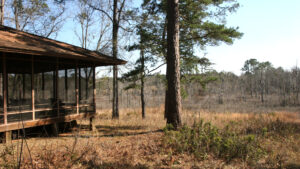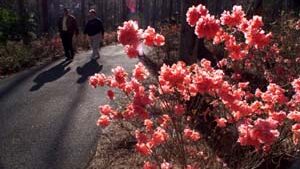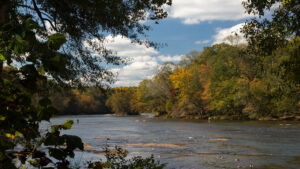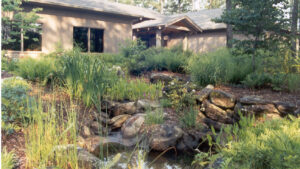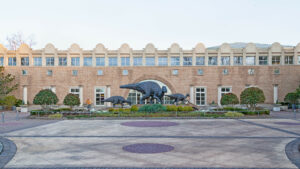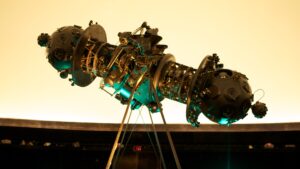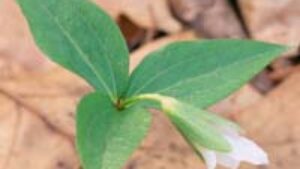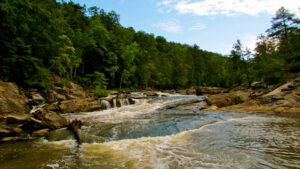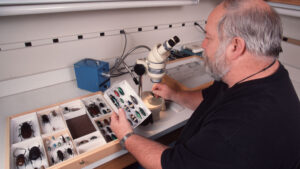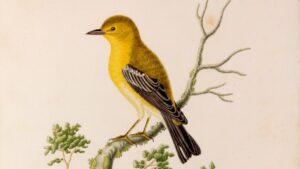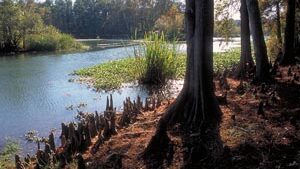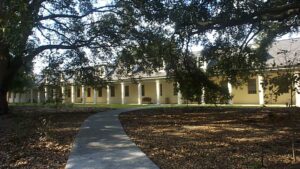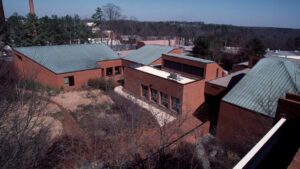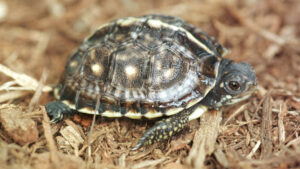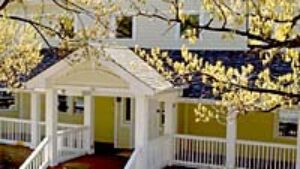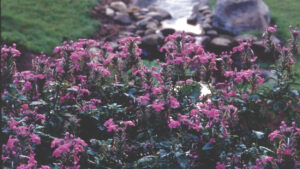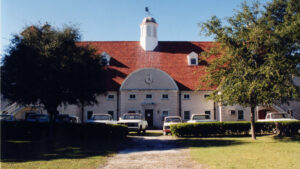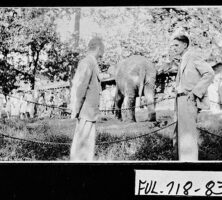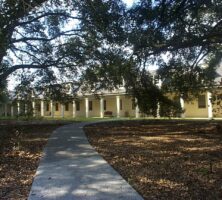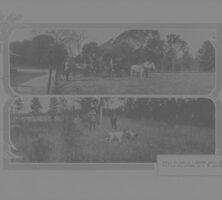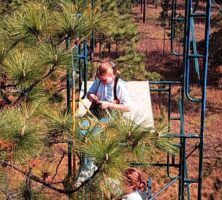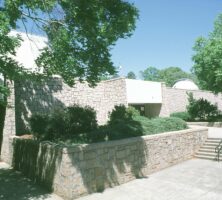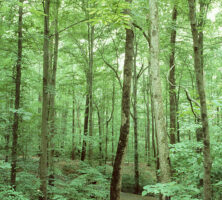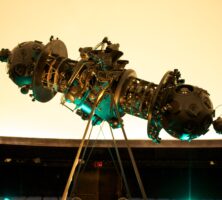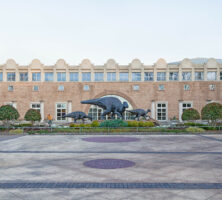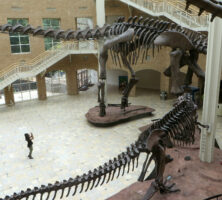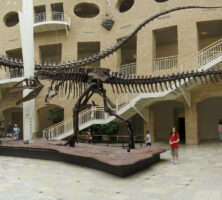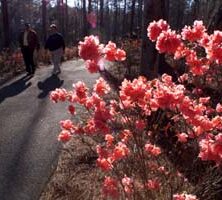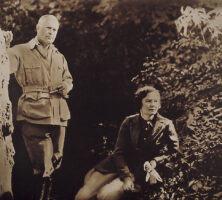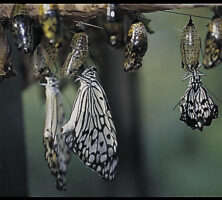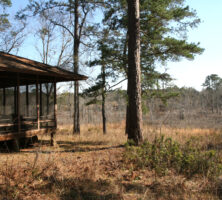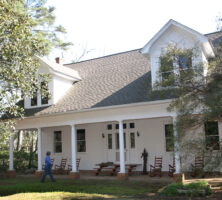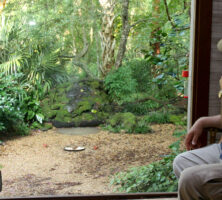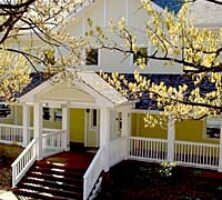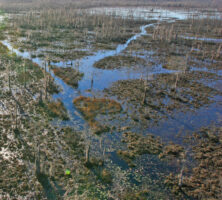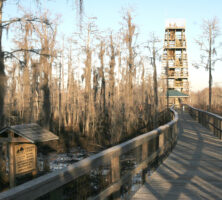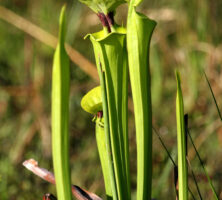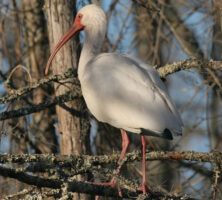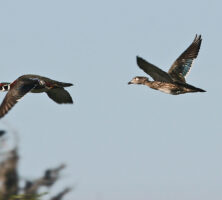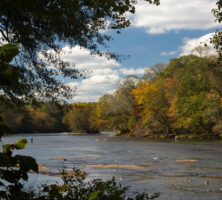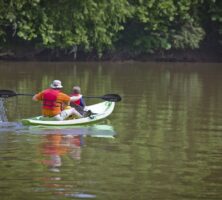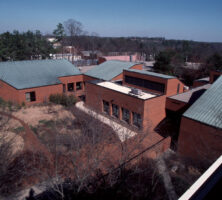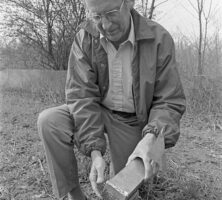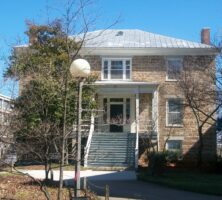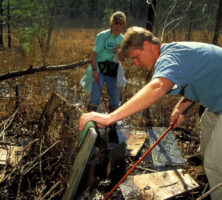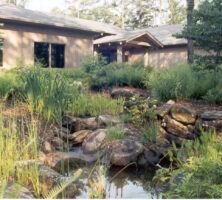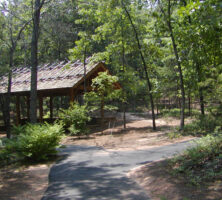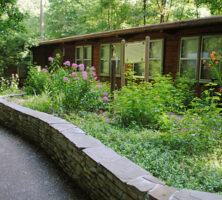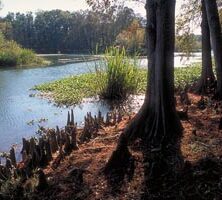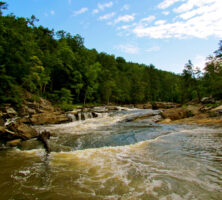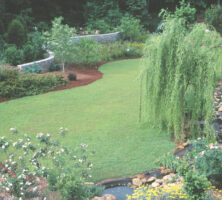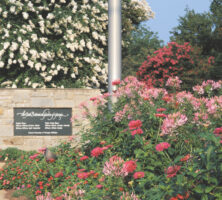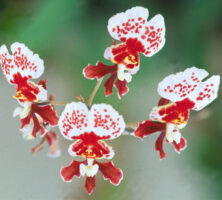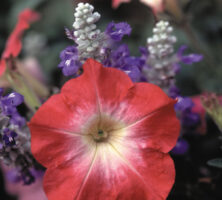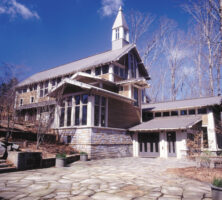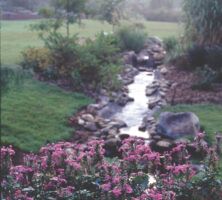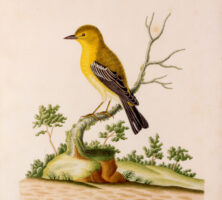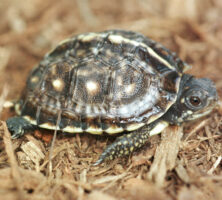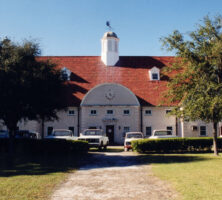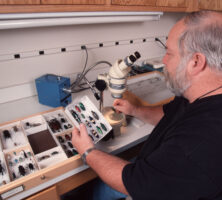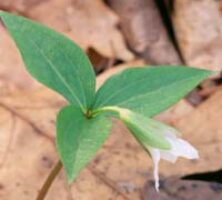The New Georgia Encyclopedia is supported by funding from A More Perfect Union, a special initiative of the National Endowment for the Humanities.
Baby giant panda Mei Lan ("Atlanta Beauty"), pictured in 2007, was born at Zoo Atlanta in September 2006. Her parents, female Lun Lun and male Yang Yang, were on loan to the zoo from Chengdu Research Base of Giant Panda Breeding in China.
Courtesy of Atlanta Journal-Constitution.
The New Georgia Encyclopedia does not hold the copyright for this media resource and can neither grant nor deny permission to republish or reproduce the image online or in print. All requests for permission to publish or reproduce the resource must be submitted to the Atlanta Journal-Constitution.
In 1999 giant pandas arrived at Zoo Atlanta, located in the city's historic Grant Park, and quickly became one of the most popular attractions at the facility. Each year more than 500,000 people visit the zoo, which focuses on education, conservation, and research.
Courtesy of Georgia Department of Economic Development.
The New Georgia Encyclopedia does not hold the copyright for this media resource and can neither grant nor deny permission to republish or reproduce the image online or in print. Requests for permission to publish or reproduce the resource may need to be submitted to the Georgia Department of Economic Development.
Visitors, pictured in 1928, observe an elephant at the Grant Park Zoo in Atlanta. The zoo was founded in 1886 with a spotted fawn, and its collection expanded to include exotic animals three years later with a donation from Atlanta businessman George V. Gress. Today the attraction is known as Zoo Atlanta.
Courtesy of Georgia Archives, Vanishing Georgia, #
ful0718-83.
The New Georgia Encyclopedia does not hold the copyright for this media resource and can neither grant nor deny permission to republish or reproduce the image online or in print. Requests for permission to publish or reproduce the resource should be submitted to the Georgia Archives.
The gorillas, as well as other animals at Zoo Atlanta, live in outdoor habitats designed to approximate their natural environments. Primates have played important roles in the zoo's history, including the arrival of Willie B., a lowland gorilla, in 1959 and the establishment of ties to the Yerkes National Primate Center in the late 1960s.
Courtesy of Georgia Department of Economic Development.
The New Georgia Encyclopedia does not hold the copyright for this media resource and can neither grant nor deny permission to republish or reproduce the image online or in print. Requests for permission to publish or reproduce the resource may need to be submitted to the Georgia Department of Economic Development.
The Joseph W. Jones Ecological Research Center at Ichauway, located in Baker County, conducts research and offers educational programs related to ecology and conservation. The center was founded upon the death of Robert Woodruff, the owner of Ichauway, in 1985, and the campus was completed in 1996.
Courtesy of Joseph W. Jones Ecological Research Center
The New Georgia Encyclopedia does not hold the copyright for this media resource and can neither grant nor deny permission to republish or reproduce the image online or in print. All requests for permission to publish or reproduce the resource must be submitted to the rights holder.
A hunting party gathers at Ichauway, in Baker County, circa 1931. Today Ichauway, founded as a quail-hunting plantation by Coca-Cola executive Robert Woodruff in 1929, is the site of the Joseph W. Jones Ecological Research Center.
Courtesy of Joseph W. Jones Ecological Research Center
The New Georgia Encyclopedia does not hold the copyright for this media resource and can neither grant nor deny permission to republish or reproduce the image online or in print. All requests for permission to publish or reproduce the resource must be submitted to the rights holder.
Researchers for the Joseph W. Jones Ecological Research Center at Ichauway, in Baker County, use an access tower to conduct research on longleaf pines. The center also conducts research in such areas as conservation biology and wetland ecology.
Courtesy of Joseph W. Jones Ecological Research Center
The New Georgia Encyclopedia does not hold the copyright for this media resource and can neither grant nor deny permission to republish or reproduce the image online or in print. All requests for permission to publish or reproduce the resource must be submitted to the rights holder.
The New Georgia Encyclopedia does not hold the copyright for this media resource and can neither grant nor deny permission to republish or reproduce the image online or in print. All requests for permission to publish or reproduce the resource must be submitted to the rights holder.
The Fernbank Science Center in Atlanta offers a variety of science education programs to the public in its planetarium, observatory, and exhibit hall. The center also offers tours through the Fernbank Forest, a sixty-five acre primeval forest adjoining the center's grounds.
Courtesy of Fernbank Science Center
The New Georgia Encyclopedia does not hold the copyright for this media resource and can neither grant nor deny permission to republish or reproduce the image online or in print. All requests for permission to publish or reproduce the resource must be submitted to the rights holder.
One of the few stands of original oak and hickory forests remaining in Georgia is located at Fernbank Forest in Atlanta. Trail guides at the Fernbank Science Center offer programs in the forest for both students and the general public throughout the year.
Courtesy of Fernbank Science Center
The New Georgia Encyclopedia does not hold the copyright for this media resource and can neither grant nor deny permission to republish or reproduce the image online or in print. All requests for permission to publish or reproduce the resource must be submitted to the rights holder.
The Jim Cherry Memorial Planetarium at the Fernbank Science Center in Atlanta houses more than 200 projectors, including the Carl Zeiss Mark V projector, which are used to simulate the night sky for students and visitors.
Image from Ryan Stavely
The New Georgia Encyclopedia does not hold the copyright for this media resource and can neither grant nor deny permission to republish or reproduce the image online or in print. All requests for permission to publish or reproduce the resource must be submitted to the rights holder.
The Fernbank Museum of Natural History in Atlanta opened in 1992 and is a partner with the Fernbank Science Center. The 160,000-square-foot museum houses several permanent exhibitions on nature and culture, in addition to the Star Gallery, the Children's Discovery Room, and a living reef aquarium.
Image from Jeremy Brooks
The New Georgia Encyclopedia does not hold the copyright for this media resource and can neither grant nor deny permission to republish or reproduce the image online or in print. All requests for permission to publish or reproduce the resource must be submitted to the rights holder.
In 2001 the Fernbank Museum of Natural History installed Giants of the Mesozoic, a permanent exhibition featuring life-size replicas of dinosaurs, in its atrium. Based on fossils found in Argentina, the replicas include two of the world's largest dinosaurs, Argentinosaurus and Gigantosaurus.
Image from Eden, Janine and Jim
The New Georgia Encyclopedia does not hold the copyright for this media resource and can neither grant nor deny permission to republish or reproduce the image online or in print. All requests for permission to publish or reproduce the resource must be submitted to the rights holder.
Replicas of the world's largest dinosaur and the world's largest carnivorous dinosaur are on display at the Fernbank Museum of Natural History in Atlanta. The Fernbank was the first museum in the world to install full-scale dinosaur skeleton replicas of this magnitude.
Image from Steve Harwood
The New Georgia Encyclopedia does not hold the copyright for this media resource and can neither grant nor deny permission to republish or reproduce the image online or in print. All requests for permission to publish or reproduce the resource must be submitted to the rights holder.
A Columbia azalea blooms along a walking path in the Callaway Brothers Azalea Bowl at Callaway Gardens in Pine Mountain. Dedicated in 1999, the Azalea Bowl is the world's largest azalea garden.
Courtesy of Atlanta Journal-Constitution.
The New Georgia Encyclopedia does not hold the copyright for this media resource and can neither grant nor deny permission to republish or reproduce the image online or in print. All requests for permission to publish or reproduce the resource must be submitted to the Atlanta Journal-Constitution.
In 1930 Cason and Virginia Callaway purchased 2,500 acres of land in Harris County upon which a number of indigenous flowering plants, including the plumleaf azalea, grew. The couple developed the land, and in 1952 they opened the Ida Cason Gardens (later Callaway Gardens) to the public.
Courtesy of Callaway Gardens
The New Georgia Encyclopedia does not hold the copyright for this media resource and can neither grant nor deny permission to republish or reproduce the image online or in print. All requests for permission to publish or reproduce the resource must be submitted to the rights holder.
The New Georgia Encyclopedia does not hold the copyright for this media resource and can neither grant nor deny permission to republish or reproduce the image online or in print. All requests for permission to publish or reproduce the resource must be submitted to the rights holder.
Japanese paperkites emerge from their cocoons in the conservatory of the Cecil B. Day Butterfly Center at Callaway Gardens. The center is the largest enclosed tropical conservatory in North America and is home to more than 1,000 butterflies.
Courtesy of Callaway Gardens
The New Georgia Encyclopedia does not hold the copyright for this media resource and can neither grant nor deny permission to republish or reproduce the image online or in print. All requests for permission to publish or reproduce the resource must be submitted to the rights holder.
The Listening Place at Birdsong Nature Center, located near Thomasville in southwest Georgia, overlooks the Big Bay Swamp and provides an isolated place for the public to observe wood ducks, alligators, snakes, and other wildlife.
Photograph by Julius F. Ariail Jr.
The New Georgia Encyclopedia does not hold the copyright for this media resource and can neither grant nor deny permission to republish or reproduce the image online or in print. All requests for permission to publish or reproduce the resource must be submitted to the rights holder.
The New Georgia Encyclopedia does not hold the copyright for this media resource and can neither grant nor deny permission to republish or reproduce the image online or in print. All requests for permission to publish or reproduce the resource must be submitted to the rights holder.
Ed and Betty Komarek purchased the Birdsong Plantation in southwest Georgia in 1938. Today the house serves as an observation area for the Birdsong Nature Center, a nonprofit educational training center founded by Betty in 1986.
Photograph by Julius F. Ariail Jr.
The New Georgia Encyclopedia does not hold the copyright for this media resource and can neither grant nor deny permission to republish or reproduce the image online or in print. All requests for permission to publish or reproduce the resource must be submitted to the rights holder.
The bird window, situated in the former dining room of the Komarek home at the Birdsong Nature Center near Thomasville, overlooks Betty Komarek's Japanese garden, where as many as 130 different bird species may be observed throughout the year. Komarek founded the center in 1986.
Photograph by Julius F. Ariail Jr.
The New Georgia Encyclopedia does not hold the copyright for this media resource and can neither grant nor deny permission to republish or reproduce the image online or in print. All requests for permission to publish or reproduce the resource must be submitted to the rights holder.
The Southface Energy Institute was founded in Atlanta in 1978 to promote the construction of environmentally sustainable homes and communities through the use of "green" technology. Consumers and builders learn to conserve energy and water, reduce waste, and maintain healthy air quality through the institute's programs.
Photograph by Neil Dent
The New Georgia Encyclopedia does not hold the copyright for this media resource and can neither grant nor deny permission to republish or reproduce the image online or in print. All requests for permission to publish or reproduce the resource must be submitted to the rights holder.
The Grand Bay Wildlife Management Area is Georgia's second-largest ecosystem, covering 18,000 acres in Lowndes County.
Photograph by Julius F. Ariail Jr.
The New Georgia Encyclopedia does not hold the copyright for this media resource and can neither grant nor deny permission to republish or reproduce the image online or in print. All requests for permission to publish or reproduce the resource must be submitted to the rights holder.
Kinderlou Tower stands at the end of a half-mile boardwalk at the Grand Bay Wetland Education Center near Valdosta. Originally a fire tower, the structure now allows visitors a view of the wetland's diverse plant and animal communities.
Photograph by Julius F. Ariail Jr.
The New Georgia Encyclopedia does not hold the copyright for this media resource and can neither grant nor deny permission to republish or reproduce the image online or in print. All requests for permission to publish or reproduce the resource must be submitted to the rights holder.
Pitcher plants grow in the savannah plant community at Grand Bay Wetland Education Center in Lowndes County. The wetland is home to a variety of plant communities, including longleaf and slash pine flatwoods, cypress and gum swamps, and shrub bogs.
Photograph by Julius F. Ariail Jr.
The New Georgia Encyclopedia does not hold the copyright for this media resource and can neither grant nor deny permission to republish or reproduce the image online or in print. All requests for permission to publish or reproduce the resource must be submitted to the rights holder.
The white ibis is one of many bird species inhabiting the Grand Bay Wildlife Management Area in Lowndes County. The Grand Bay wetland is a designated bird-watching site along the Southern Rivers Birding Trail and offers glimpses of a variety of birds, including egrets, hawks, owls, and woodpeckers.
Photograph by Julius F. Ariail Jr.
The New Georgia Encyclopedia does not hold the copyright for this media resource and can neither grant nor deny permission to republish or reproduce the image online or in print. All requests for permission to publish or reproduce the resource must be submitted to the rights holder.
Wood ducks fly over the Grand Bay Wildlife Management Area in Lowndes County, which includes the 18,000-acre Grand Bay/Banks Lake ecosystem.
Photograph by Julius F. Ariail Jr.
The New Georgia Encyclopedia does not hold the copyright for this media resource and can neither grant nor deny permission to republish or reproduce the image online or in print. All requests for permission to publish or reproduce the resource must be submitted to the rights holder.
The Chattahoochee River, as seen in Peachtree Corners, Georgia.
Image from Marcus Williams
The New Georgia Encyclopedia does not hold the copyright for this media resource and can neither grant nor deny permission to republish or reproduce the image online or in print. All requests for permission to publish or reproduce the resource must be submitted to the rights holder.
The Chattahoochee River is a popular recreation spot for canoers, kayakers, and tubers.
Courtesy of Explore Georgia, Photograph by Ralph Daniel.
The New Georgia Encyclopedia does not hold the copyright for this media resource and can neither grant nor deny permission to republish or reproduce the image online or in print. Requests for permission to publish or reproduce the resource may need to be submitted to Explore Georgia.
The Eugene P. Odum School of Ecology is the primary academic unit for ecological research and teaching at the University of Georgia.
Courtesy of University of Georgia Photographic Services. Photograph by Paul Efland
The New Georgia Encyclopedia does not hold the copyright for this media resource and can neither grant nor deny permission to republish or reproduce the image online or in print. All requests for permission to publish or reproduce the resource must be submitted to the rights holder.
Odum was instrumental in the founding of the University of Georgia's Savannah River Ecology Laboratory, University of Georgia Marine Institute on Sapelo Island, and the Institute of Ecology, which was later renamed in his honor.
Courtesy of University of Georgia Photographic Services
The New Georgia Encyclopedia does not hold the copyright for this media resource and can neither grant nor deny permission to republish or reproduce the image online or in print. All requests for permission to publish or reproduce the resource must be submitted to the rights holder.
The Rock House, on the University of Georgia's south campus, overlooks the Tanyard Creek ravine and Sanford Stadium. The structure was the first home of the Institute of Ecology (later Odum School of Ecology).
Photograph from GeorgiaInfo
The New Georgia Encyclopedia does not hold the copyright for this media resource and can neither grant nor deny permission to republish or reproduce the image online or in print. All requests for permission to publish or reproduce the resource must be submitted to the rights holder.
Members of professor Whit Gibbons's staff search for snakes along marshy areas of the Savannah River Ecology Lab.
Courtesy of University of Georgia Photographic Services. Photograph by Rick O'Quinn
The New Georgia Encyclopedia does not hold the copyright for this media resource and can neither grant nor deny permission to republish or reproduce the image online or in print. All requests for permission to publish or reproduce the resource must be submitted to the rights holder.
The Alcovy Conservation Center in Covington serves as the Georgia Wildlife Federation's headquarters and as a training ground for environmental activists and educators.
The New Georgia Encyclopedia does not hold the copyright for this media resource and can neither grant nor deny permission to republish or reproduce the image online or in print. All requests for permission to publish or reproduce the resource must be submitted to the rights holder.
The New Georgia Encyclopedia does not hold the copyright for this media resource and can neither grant nor deny permission to republish or reproduce the image online or in print. All requests for permission to publish or reproduce the resource must be submitted to the rights holder.
Sawnee Mountain Preserve, a 720-acre park in Forsyth County, opened to the public in 2005. Built on abandoned mining lands, the park offers hiking, rock climbing, and environmental education to vistors.
Photograph by Melinda S. Mullikin, New Georgia Encyclopedia
The New Georgia Encyclopedia does not hold the copyright for this media resource and can neither grant nor deny permission to republish or reproduce the image online or in print. All requests for permission to publish or reproduce the resource must be submitted to the rights holder.
The New Georgia Encyclopedia does not hold the copyright for this media resource and can neither grant nor deny permission to republish or reproduce the image online or in print. All requests for permission to publish or reproduce the resource must be submitted to the rights holder.
The W. H. Reynolds Memorial Nature Preserve is named for Judge William Reynolds, who donated 130 acres of wetlands to Clayton County in 1976. In 1997 the preserve obtained an additonal sixteen acres adjacent to the original property, including primarily hardwood forests, as well as ponds, wetlands, streams, designated picnic areas, and four miles of well-defined footpaths. The preserve promotes environmental education and is open to the public.
Courtesy of UGA Archway Partnership
The New Georgia Encyclopedia does not hold the copyright for this media resource and can neither grant nor deny permission to republish or reproduce the image online or in print. All requests for permission to publish or reproduce the resource must be submitted to the rights holder.
Cypress trees line the Flint River, which supports one of the state's unique local ecosystems. During the 1970s, the Georgia Wildlife Federation successfully fought the construction of a dam on the river in an effort to preserve Sprewell Bluff in Upson County.
Courtesy of Georgia Department of Economic Development.
The New Georgia Encyclopedia does not hold the copyright for this media resource and can neither grant nor deny permission to republish or reproduce the image online or in print. Requests for permission to publish or reproduce the resource may need to be submitted to the Georgia Department of Economic Development.
The Georgia Conservancy acquired more than 2,000 acres in Douglas County in the late 1960s, which became Sweetwater Creek State Park. Sweetwater Creek runs through the Lithia Springs park on its way to the Chattahoochee River. The acquisition of this land for the state was one of the conservancy's earliest victories.
Photograph by Jeff Gunn
The New Georgia Encyclopedia does not hold the copyright for this media resource and can neither grant nor deny permission to republish or reproduce the image online or in print. All requests for permission to publish or reproduce the resource must be submitted to the rights holder.
The International Garden explores the interrelationship of plants and people throughout civilization and contains representative species from the floras of the Mediterranean region, Latin America, China, and the southeastern United States.
Courtesy of the State Botanical Garden of Georgia
The New Georgia Encyclopedia does not hold the copyright for this media resource and can neither grant nor deny permission to republish or reproduce the image online or in print. All requests for permission to publish or reproduce the resource must be submitted to the rights holder.
The State Botanical Garden of Georgia is a "living laboratory" serving teaching, research, public service, and outreach missions for the University of Georgia and the citizens of Georgia.
Courtesy of the State Botanical Society of Georgia
The New Georgia Encyclopedia does not hold the copyright for this media resource and can neither grant nor deny permission to republish or reproduce the image online or in print. All requests for permission to publish or reproduce the resource must be submitted to the rights holder.
The theme gardens, collections, and display beds contain a diverse array of both native and exotic plant species, including orchids.
Courtesy of the State Botanical Garden of Georgia
The New Georgia Encyclopedia does not hold the copyright for this media resource and can neither grant nor deny permission to republish or reproduce the image online or in print. All requests for permission to publish or reproduce the resource must be submitted to the rights holder.
The Annual and Perennial Garden, one of the most colorful areas in the entire garden, includes the All-America Selections Display Garden.
Courtesy of the State Botanical Garden of Georgia
The New Georgia Encyclopedia does not hold the copyright for this media resource and can neither grant nor deny permission to republish or reproduce the image online or in print. All requests for permission to publish or reproduce the resource must be submitted to the rights holder.
The New Georgia Encyclopedia does not hold the copyright for this media resource and can neither grant nor deny permission to republish or reproduce the image online or in print. All requests for permission to publish or reproduce the resource must be submitted to the rights holder.
The Alice Hand Callaway Visitor Center and Conservatory was completed in 1984 and contains offices, classrooms, a gift shop, the Garden Room Cafe, and a 10,000-square-foot conservatory featuring tropical plants of economic interest.
Courtesy of the State Botanical Garden of Georgia
The New Georgia Encyclopedia does not hold the copyright for this media resource and can neither grant nor deny permission to republish or reproduce the image online or in print. All requests for permission to publish or reproduce the resource must be submitted to the rights holder.
The Day Chapel, completed in 1994, was the third major building constructed at the State Botanical Garden. Modern in design, the chapel contains an eclectic combination of styles and details.
Courtesy of the State Botanical Garden of Georgia
The New Georgia Encyclopedia does not hold the copyright for this media resource and can neither grant nor deny permission to republish or reproduce the image online or in print. All requests for permission to publish or reproduce the resource must be submitted to the rights holder.
The International Garden at the State Botanical Garden of Georgia pays homage to John and William Bartram, who discovered the Franklin Tree (named in honor of Benjamin Franklin), and Ernest Henry "Chinese" Wilson, who introduced Asian varieties to the Southeast.
Courtesy of the State Botanical Garden of Georgia
The New Georgia Encyclopedia does not hold the copyright for this media resource and can neither grant nor deny permission to republish or reproduce the image online or in print. All requests for permission to publish or reproduce the resource must be submitted to the rights holder.
The New Georgia Encyclopedia does not hold the copyright for this media resource and can neither grant nor deny permission to republish or reproduce the image online or in print. All requests for permission to publish or reproduce the resource must be submitted to the rights holder.
John Abbot painted his Yellow Breasted Finch (watercolor on paper, 11 1/8" x 8 3/4") in 1790, fifteen years after moving from Virginia to Georgia. A native of England, Abbot traveled to America in 1773 and spent the remainder of his life collecting and drawing specimens of New World birds, insects, and butterflies.
Courtesy of Morris Museum of Art
The New Georgia Encyclopedia does not hold the copyright for this media resource and can neither grant nor deny permission to republish or reproduce the image online or in print. All requests for permission to publish or reproduce the resource must be submitted to the rights holder.
The New Georgia Encyclopedia does not hold the copyright for this media resource and can neither grant nor deny permission to republish or reproduce the image online or in print. All requests for permission to publish or reproduce the resource must be submitted to the rights holder.
The New Georgia Encyclopedia does not hold the copyright for this media resource and can neither grant nor deny permission to republish or reproduce the image online or in print. All requests for permission to publish or reproduce the resource must be submitted to the rights holder.
The eastern box turtle is the only resident species of turtle on the Savannah River Site that is primarily terrestrial.
Image from Stannatsw
The New Georgia Encyclopedia does not hold the copyright for this media resource and can neither grant nor deny permission to republish or reproduce the image online or in print. All requests for permission to publish or reproduce the resource must be submitted to the rights holder.
The University of Georgia Marine Institute was founded primarily as a research institute for salt marsh, watershed, and nearshore ecosystems. The goals of the research are to understand the biological, chemical, geological, and physical processes that control salt marsh systems.
Photograph by Darby Carl Sanders, New Georgia Encyclopedia
The New Georgia Encyclopedia does not hold the copyright for this media resource and can neither grant nor deny permission to republish or reproduce the image online or in print. All requests for permission to publish or reproduce the resource must be submitted to the rights holder.
The collections at the UGA museum grow by more than 25,000 specimens each year. Here, a scientist inspects specimens in the arthropod (mites and insects) collection.
Courtesy of University of Georgia Photographic Services
The New Georgia Encyclopedia does not hold the copyright for this media resource and can neither grant nor deny permission to republish or reproduce the image online or in print. All requests for permission to publish or reproduce the resource must be submitted to the rights holder.
Trillium persistens, an endangered plant found in northeast Georgia, is one of the plants that the Georgia Botanical Society helps to monitor.
Reprinted with permission from Hugh and Carol Nourse
The New Georgia Encyclopedia does not hold the copyright for this media resource and can neither grant nor deny permission to republish or reproduce the image online or in print. All requests for permission to publish or reproduce the resource must be submitted to the rights holder.
